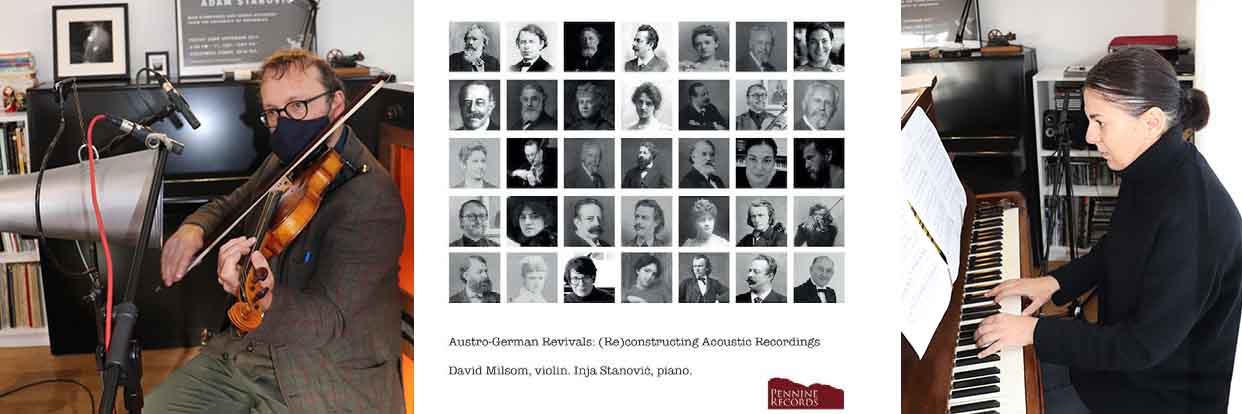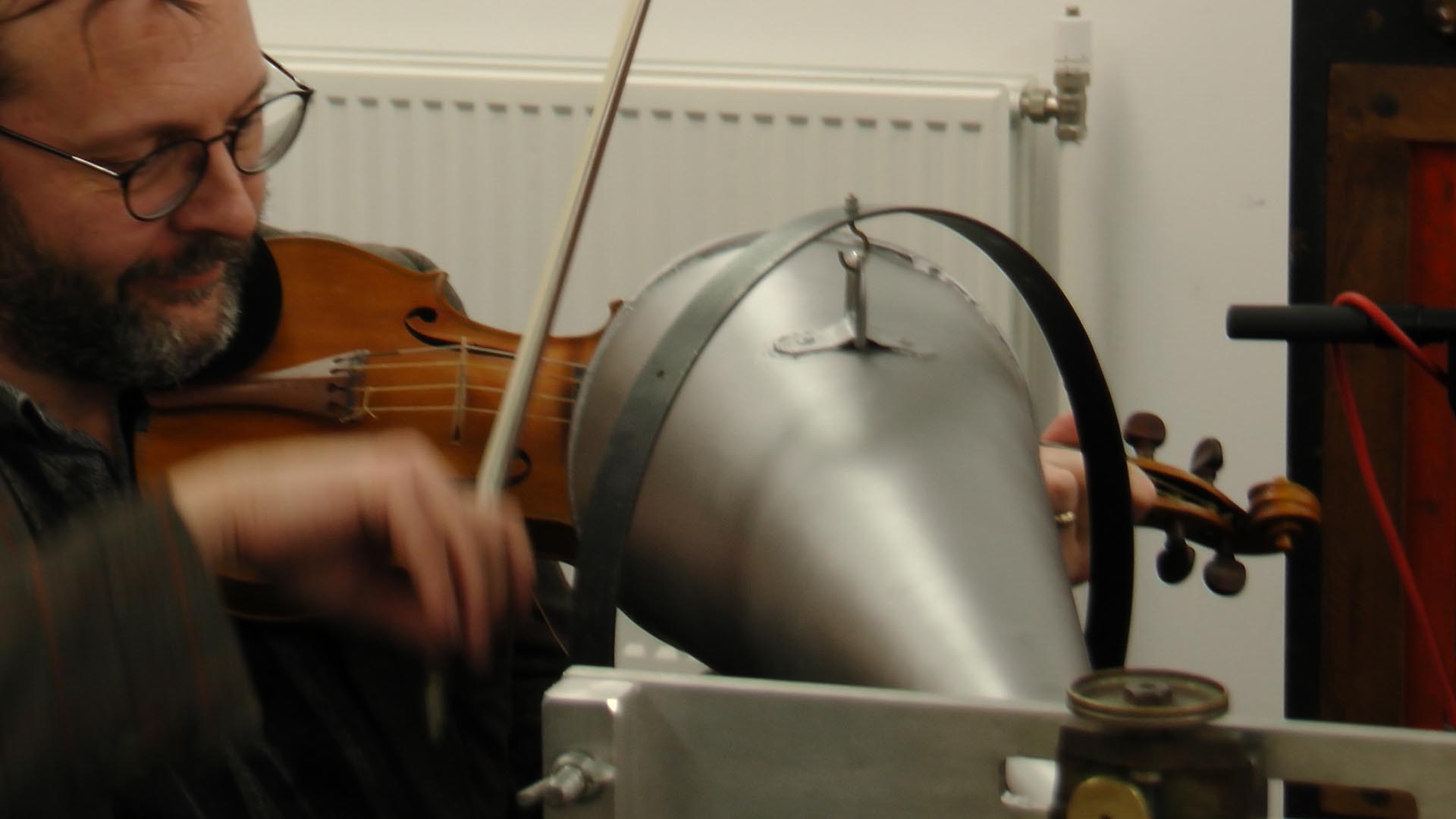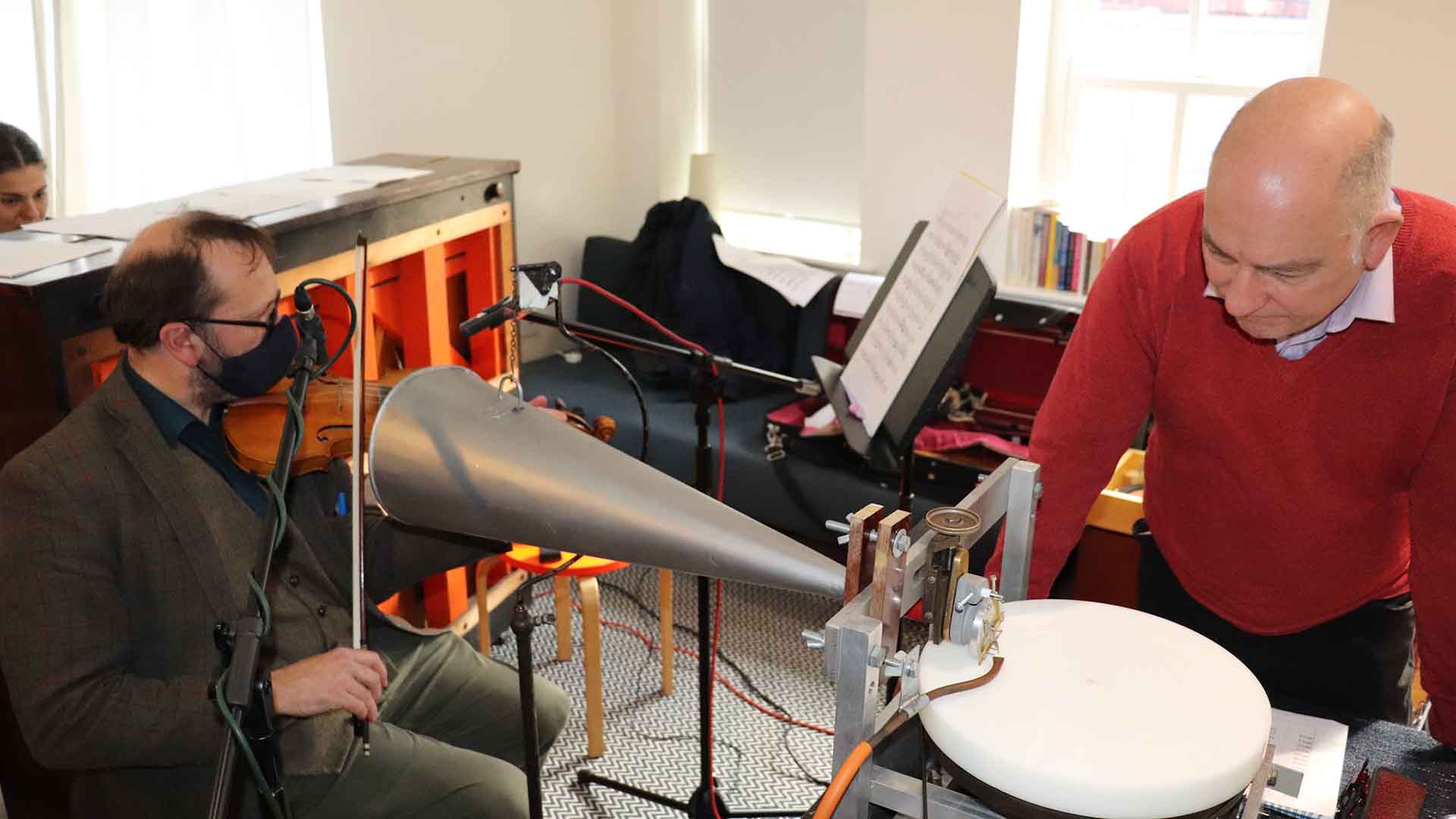The ghostly sounds of pre-electric recordings can be heard on a new album issued by the University of Huddersfield Press.
But Pennine Records’ Austro-German Revivals: (Re)constructing Acoustic Recordings are not the sounds of long-dead musicians, however, but new recordings made by two present-day researcher-performers.
Both are members of the Historical Performance Research Group in the Department of Music and Design Arts at Huddersfield: violinist Dr David Milsom, who heads up classical performance studies at Huddersfield, and pianist Dr Inja Stanović.
Inja's Leverhulme-funded research project, (Re)constructing Early Recordings: a guide for historically-informed performance, brought the idea of using historic recording technologies to Huddersfield and was the catalyst for Austro-German Revivals: (Re)constructing Acoustic Recordings.
An essential innovative feature here is the use of historic recording technology in what Dr Milsom and Dr Stanović have hailed as a ‘game-changing’ project. This set of brand-new acoustic recordings were put together using rare equipment that uses the same processes for recording music as existed before the widespread adoption of the electric microphone after 1925. The music itself is a wide-ranging collection of shorter works by Bach, Brahms and Mendelssohn, amongst others.
 David Milsom and Inja Stanovic with the cover of Austro-German Revivals: (Re)constructing Acoustic Recordings
David Milsom and Inja Stanovic with the cover of Austro-German Revivals: (Re)constructing Acoustic Recordings It is the second release from Pennine Records, set up by David as a partnership between the music department and University of Huddersfield Press in 2020. The purpose of the label was to showcase a wide range of research-based ways of performing historical music. The first release, which also features David as violinist/violist, was made using cutting-edge modern technology and contemporary performance style and shows the intended contrasts the label was set up to espouse.
David and Inja are performance practice specialists in music performance of the late 19th and early 20th centuries, and this project represented a chance to build upon traditional sound recordings research to produce something that is at the same time very old, and while also innovative and new.
“I had wanted the experience of making recordings this way for years, so when Inja and I got the chance towards the end of her Leverhulme project to make some recordings by the acoustic process, it was something we absolutely had to do and so we jumped at the chance,” says David.
It has been an absolutely extraordinary, game-changing practice research experience and I hope that it will be a shop window on the current state of historical performance research. We are not only people who write about style in historical recordings, we are also professional, performing musicians.
Dr David Milsom
“In this sense, the recording is another instance of why Huddersfield is such a vibrant environment for music performance research: many of us here are practicing musicians as well as lecturers and academics. This project was only possible by both of those things working together.”
Inja is a conservatoire-trained pianist from Croatia, who came to Huddersfield after following her PhD at the University of Sheffield by securing a Leverhulme Early Career Fellowship.
Serendipity dictated that the equipment to make wax disc recordings (a tale of recording horns, cutting styluses, and the manufacture of wax discs themselves into which the vibrations are indented) – and, crucially, an engineer capable of making these recordings in a highly-skilled process widely thought to have been lost to history – were available in nearby Sheffield in the shape of the internationally-renowned Duncan Miller at Vulcan Records. "It was a case of the right people in the right place at the right time,” David adds.

Inja’s husband Dr Adam Stanović transferred the recordings from the wax discs into a digital form, allowing them to be available online. The project itself continues Inja's previous research into how acoustic recordings can be understood as historical documents of an increasingly distant past.
“Musically it is extremely important to research this, but also to actually do them,” says Inja. “Research, in this context, is not only about listening and writing; it is also about playing, and putting yourself in the shoes of historical musicians, accepting the small imperfections that are an inevitable consequence of a one-take recording and a wax recording medium.
Huddersfield’s supportive environment aids the creative process
“This is the first-ever systematic study of these machines. Previously studies have been short-term and smaller projects, not an extensive one unfolding over a number of years. I started around six years ago, and have produced a huge number of wax discs and cylinders. I developed recording techniques and then incorporated all my colleagues, including David, as well as Huddersfield Visiting Research Fellow and historical cello specialist Dr George Kennaway, amongst others.
“Huddersfield was the ideal environment to do this because of its supportive performance culture, and a number of nearby or Huddersfield-based historical performance researchers.”
But it is not just the recording techniques of the time that have been a revelation, David says that the research highlighted differences in the manner of performance given the available technology.
 Inja, David and Duncan Miller (right) using pre-electric era recording equipment.
Inja, David and Duncan Miller (right) using pre-electric era recording equipment.“The collection includes some unaccompanied piano music and some violin, putting together some of the repertoire performed by very famous pianists and violinists of the Austro-German tradition in the early 20th Century,” adds David. “We have undergone a research process to emulate, to a degree, how they did that in terms of the performance style. We talk about the process in the notes accompanying the new recordings album.
“We have listened to original sound documents, taken substantial cues from thorough analytical listening, knowledge of specialisms in our research field and then we have closed the circle by re-recording it ourselves in a fascinating process of cyclical learning and experience, influenced by historical sound documents to create brand-new recordings by very old-fashioned technology. They are, but they are very much intended to be from the same ‘aesthetic stable’ to a number of historical figures who inspired these new recordings.
“Our performances can be compared closely to the historical documents we studied, and feedback from a number of international experts (including Professor Neal Peres Da Costa at the Sydney Conservatorium) has been very positive not only as an interesting research project in itself but also because the recordings sound ‘right’ in this historical context.
“I like to think that we have captured something of the performance style of some famous musicians from the dawn of the twentieth century, whilst being true to our own ideals as artists in our own rights. I hope others hear this in what we have done here.”
